In Japanese, the seiza 正座, meaning "proper sitting," is the formal, proper way to sit on the floor: on your knees—traditionally used in tea ceremonies.
Not to be confused with the homonym seiza 星座, which means "constellation."
Definition
The word seiza 正座, or 正坐, refers to the pose of "sitting one your knees." It's a noun, but can be used as a suru verb.
- seiza suru
正座する
To seiza. (literally.)
To sit on your knees.
Sometimes, seiza is translated as "proper sitting," due to the meaning of its kanji:
- {tadashii} suwari-kata
正しい座り方
The way-of-sitting [that] {is correct}.
The correct way of sitting.
The proper way to sit.- suwaru
座る
To sit.
- suwaru
Although the Japanese custom of sitting on your knees is very old, the term seiza to refer to this pose is relatively recent, dating from the 20th century. Before that, seiza was called tanza 端座, among other terms, instead.(nobunsha.jp)
Pose
The seiza pose is done by sitting on one's knees with knees and feet next to each other, hands rested on one's lap, like this:
Anime: Hyouge Mono へうげもの (Episode 2, Stitch)
If the feet are apart so that you aren't sitting on them, that's a different pose called wariza 割座 (W sitting), also known as onna-no-ko-suwari 女の子座り, "girl's sitting," in the sense that only girls sit this way, and not boys, which doesn't make a lot of sense, but that's how it's called anyway.
Right: Hashiba Natsuki 羽柴夏樹
Anime: Nijiiro Days, 虹色デイズ (Episode 7)
- Context: the girl on the left sits in wariza, while the boy on the right sits in seiza.
Middle: Yasaka Mahiro 八坂真尋
Right: Nyaruko ニャル子
Anime: Haiyore! Nyaruko-san 這いよれ!ニャル子さん (Episode 3)
- Context: three characters sit differently.
- Left: wariza.
- Middle: tate-hiza 立膝.
- Right: seiza.
If both feet are to one side, that's instead called yokozuwari 横座り, "side sitting." Also known as onnazuwari 女座り, "woman sitting," as this one, too, is associated with women.
Anime: Zombieland Saga, ゾンビランドサガ (Episode 6)
Japanese Custom
Why do Japanese people sit on their knees on the floor? There are practical and historical reasons for this.
Let's start with the obvious: kneeling on the floor hurts, specially for long periods of time, so one has to wonder what's up with Japanese people to deliberately subject themselves to this world of pain.
The answer lies on the floor.
Traditionally, Japanese homes were floored with tatami mats, and the tatami 畳, being softer than wood or stone, doesn't hurt as much to kneel on. On top of that, I mean, on top of the tatami, people often use a pillow thing that serves as seat, so they don't even kneel on the floor directly.
- Context: a character wrapped in a blanket like a burrito sits on the floor.
- zabuton
座布団
The term for the "seat cushion" under her, that serve as a seiza seat.
Middle: Emiya Shirou 衛宮士郎
Right: Saber セイバー
Anime: Fate/stay night: Unlimited Blade Works (Episode 5)
- Context: characters seiza to eat.
- zataku
座卓
A table made to be used while sitting on the floor. Literally "sitting table."
That said, it's still uncomfortable to sit in seiza position for long periods of time.
Japan, of course, has chairs, as does any country in the modern world, so if there are chairs available to sit on, people would obviously just sit on the chairs.
It's not like they'd just throw the chair away and sit on the floor, sulking, that would be ridiculous.
It just happens that, In the modern world, some houses have have more traditional "Japanese-style rooms," washitsu 和室, with tatami floors, and some situations are more ceremonial. In such cases, it's normal to sit on the floor instead of on chairs.
Nowadays, Japanese houses are often built western-style, without tatami, which leads to the usage of seiza to decrease over time.
Middle: Uesugi Fuutarou 上杉風太郎
Right: Nakano Yotsuba 中野四葉
Anime: Gotoubun no Hanayome 五等分の花嫁 (Episode 1)
- Context: seiza on wooden floor.
Other cultures, like China's, do have a practice of sitting on your knees for some reason or another, but they don't have tatami floors, so people of those cultures don't normally sit on their knees to do stuff the way Japanese people do.
The tatami is traditionally made out of rice plants, by the way, and rice is extensively cultivated in Japan.
Origin
The seiza as a Japanese custom originates in tea ceremonies, sadou 茶道, during the Muromachi 室町 period (1333–1573).(nobunsha.jp)
Right: Mohammed Avdol モハメド・アヴドゥル
Anime: JoJo no Kimyou na Bouken ジョジョの奇妙な冒険 - Part 3: Stardust Crusaders (Episode 2)
- sadou, or chadou
茶道
Way of the tea. (literally.)
The practice of tea ceremonies, as an art and as a philosophy.- cha
茶
Tea.
- cha
To elaborate: while seiza is definitely one way to sit on the floor, it's obviously not the only way to sit on the floor. Another common way is sitting with your legs crosses, this is called agura 胡座 instead.
- Context: seiza, agura, seiza.
With tea ceremonies, however, there's emphasis on keeping things ceremonial, with proper procedures, etiquette, etc. You can't just sit however you want. There must be one way to do it properly, and the seiza ended up being that way.
- Saying certain phrases upon offering, receiving and drinking the tea, and rotating the cup a specific number of times before drinking are other examples of proper procedure in such ceremonies.
Why the seiza, though, and not the agura? Who knows. Presumably, sitting with your legs closed, and your feet behind you, looks more proper than sitting cross-legged or with your feet in front of you. In any case, the seiza was chosen, and not any other pose.
The history between these things can be summarized like this(nobunsha.jp):
- In the Heian 平安 period (794–1185) , the tatami was used as beds, rather than as flooring.
- The term tatami is the noun form of tatamu 畳む, "to fold," because the tatami were originally meant to folded when not in use.(gogen-allguide.com)
- In the Kamakura 鎌倉 period (1185–1333), it began being used as flooring, but only in the houses of nobles, it wasn't an item the common Japanese person would have.
- In the Muromachi 室町 period (1333–1573), tea ceremonies started being held in the nobles' tatami-floored rooms, and part of the proper etiquette, the way of the tea, was sitting in seiza position.
- Before this, seiza meant submission, and was only used in worship or before one's superiors.
- Since it was only used in these two cases, plus tea ceremonies, it's safe to say it was the tea ceremony, typically conducted on a tatami-floored room, that made seiza part of the common Japanese culture.
- In the Edo 江戸 period (1603–1868), the tatami flooring was an essential part of the houses of nobles and warriors.
- In he Meiji 明治 period (1868–1912), the tatami flooring became commonplace in houses of commoners, and along with it came the seiza.
- In the Shouwa 昭和 period (1926–1989), the term seiza started being used to refer to the pose.
Given the above, although seiza dates back all the way to around the 14th century, it only got really popular in the 19th century, since seiza spread mainly through the tea, and the tea also spread the tatami, as the tatami became popular, so did the seiza.
Usage
For reference, some ways the seiza is used.
Scolding
In anime, when a character is getting scolded for something they've perpetrated, they may be forced to sit on their knees while listening to the sermon.
Left: Selen Hemein, セレン・ヘムアエン (a.k.a. Selenium, Heme & Zinc)
Right: Phyllo Kinon, フィロ・キノン (a.k.a. Vitamin K1)
Anime: Tatoeba Last Dungeon Mae no Mura no Shounen ga Joban no Machi de Kurasu You na Monogatari, たとえばラストダンジョン前の村の少年が序盤の街で暮らすような物語 (Episode 9)
Middle: Tainaka Ritsu 田井中律
Right: Hirasawa Yui 平沢唯
Anime: K-On!, Keion! けいおん! (Episode 4)
Left: Gobutsu ゴブツ
Middle: Gobuto ゴブト
Right: Gobuta ゴブタ
Rightmost: Gobuzou ゴブゾウ
Anime: Tensei Shitara Slime Datta Ken, 転生したらスライムだった件 (Season 2) (Episode 4, エルフを求めてドワーフの国へ!)
Subordination
Even if they aren't being scolded, sometimes characters seiza to listen to the very important stuff that another character is saying, in which case the character standing clearly seems superior, like a captain, while the ones sitting are like subordinates.
Anime: Minami-ke みなみけ (Episode 7)
- Context: Minami Kana explains other girls they shouldn't accept money or gifts from strange older men.
Corporal Punishment
As mentioned previously, kneeling on hard floor hurts, so sometimes the seiza is used as a method of corporal punishment, used for example on misbehaving school children.
Nowadays there are laws against this, I think, and this practice, together with making students stand on the corridor, has fallen out of usage.
Elsewhere in the world, not seiza specifically, but kneeling on the floor on something bead-like, like corn seeds, was also used a method of punishment.
Torture Method
The seiza is part of a literal torture method once used on criminals in Japan: the ishi-daki 石抱き, "stone-hugging," in which someone is made kneel on a ridged rood block, and then stone blocks are placed over their legs.
Left: Kinoshita Hideyoshi 木下秀吉
Center-left: Yoshii Akihisa 吉井明久
Center-right: Tsuchiya Kouta 土屋康太
Right: Himeji Mizuki 姫路瑞希
Rightmost: Shimada Minami 島田美波
Anime: Baka to Test to Shoukanjuu Ni'!, !バカとテストと召喚獣 にっ! (Season 2) (Episode 5)
- Narration:
- ishi-daki, betsumei soroban-zeme tomo iwareru, Edo-jidai no goumon de aru
石抱き、別名算盤責めとも言われる、江戸時代の拷問である
Stone-hugging, also called abacus-torture, is a torture [method] from the Edo period.
Prostration
The seiza influences how prostration is done in Japan, that's because the dogeza 土下座, a grovelling pose used to beg or apologize, starts with a seiza.
As a consequence, while elsewhere in the world you'd prostrate yourself by getting on all fours first, butt up, in Japan it's typically done by sitting on your knees first, butt down, so it looks more narrow and horizontal than diagonal.
For reference, an actual example:
Lap Pillow
The typical Japanese "lap pillow," hizamakura 膝枕, features a seiza: someone sits on the knees and someone else places their head on that person's lap.
Head: Yagyuu Binbokusai 柳生 敏木斎
Anime: Gintama 銀魂 (Episode 77)
References
- 畳 - gogen-allguide.com, accessed 2021-03-16
- 日本人は、「畳に正座する」民族である。 - nobunsha.jp, accessed 2021-03-12.
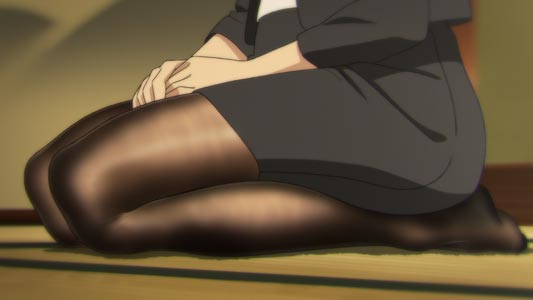
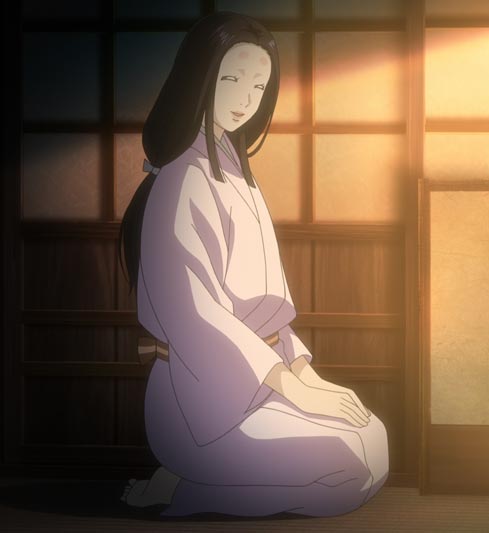
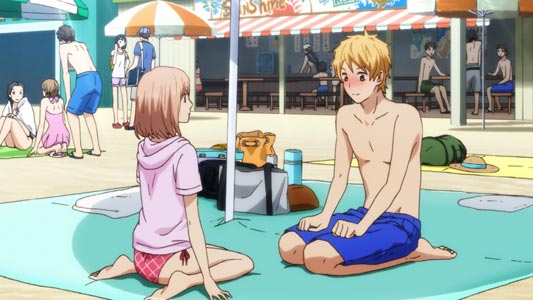

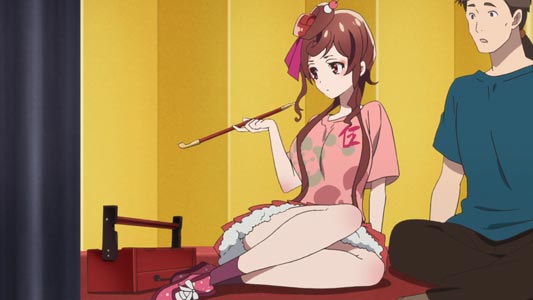
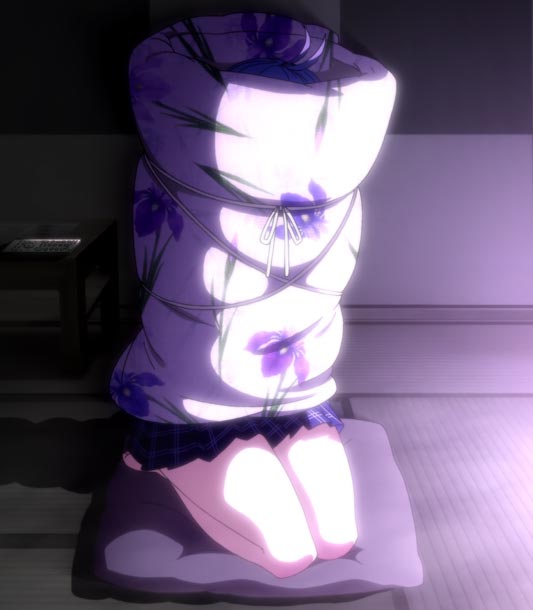
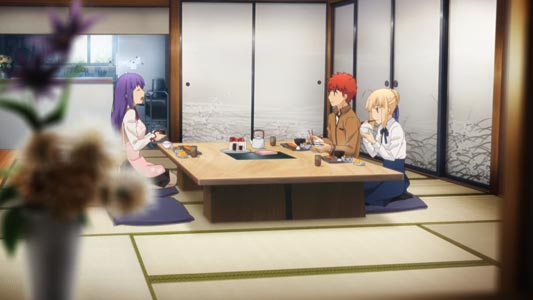
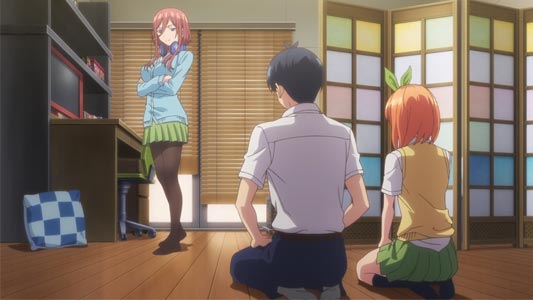





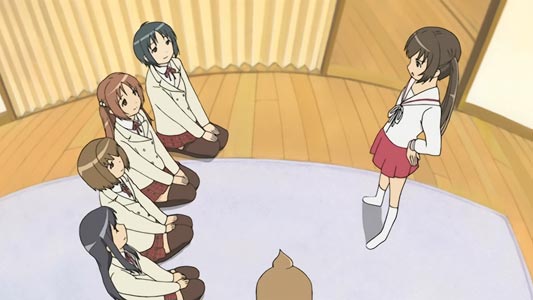
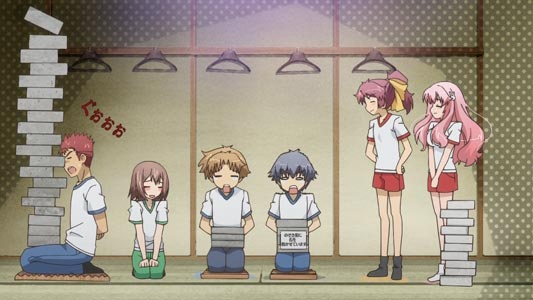
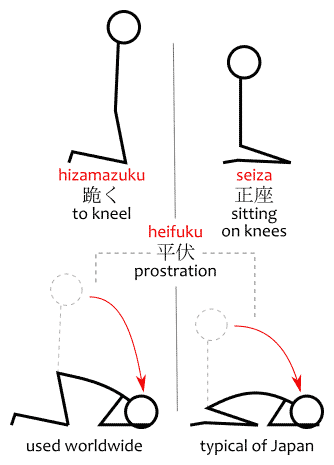
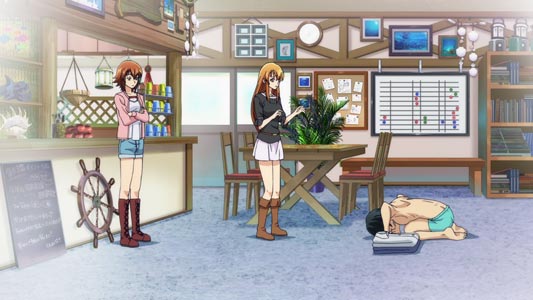

No comments: